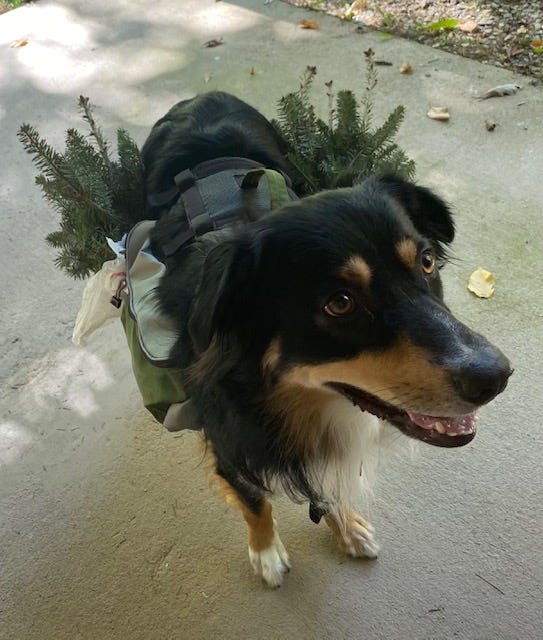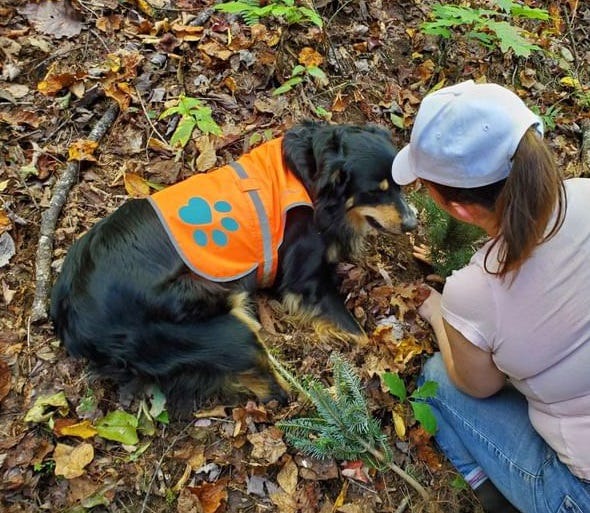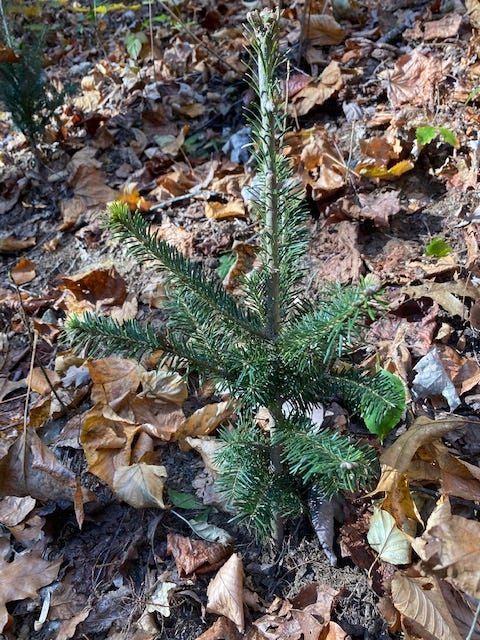Planting 101 trees with permaculture principles
With my husband and Australian shepherd’s help, I planted 101 trees by hand.
Earlier this month the first batch of Fraser firs arrived for my permaculture Christmas tree farm experiment. This experiment spans sites from 2,300’ to 2,600’ elevation in Western North Carolina. Instead of clearcutting the woods and planting the trees in a typical monoculture fashion, I sited planting areas within the existing landscape and transplanted the trees with permaculture practices and principles.
Observe and interact, plus use edges
I’ve been observing the woods through the past few seasons while the tree canopy is fully leafed. I looked for areas consistently showing dappled light. Since most of the property is steep, I knew I would have planting areas with slope, which can help with future erosion control. I also chose some areas with high densities of mountain laurel and maple, which indicate the type of soil Fraser firs prefer. I also used the edges of these areas – another permaculture practice that recognizes high abundance along edges. Edge areas provide resilient ranges of microclimates, various habitats, and foster biodiversity.
Use and value renewable resources
Although not set up, there’s an option to have gravity-fed water from a mountain spring with half of these initial planting sites. Aside from irrigation from this existing resource, the spring causes a few tricky trail and access crossings, so my hope is to create a few foot bridges from existing trees we can harvest.
Integrate rather than segregate, plus obtain a yield
I combined more permaculture practices when I recognized my strawberry plants at home in the Piedmont of North Carolina produced many offspring this year. I have so many strawberry runners from an alpine variety, so they may be even happier and more productive in a mountain habitat. I potted up a few dozen runners, which will serve as a no-maintenance fir ground cover, living mulch, and snack producer for me when I visit the trees for trimming and maintenance. Bee balm is another plant in abundance in my home garden and yard, so I brought some seedlings out and transplanted them with the fir too. Read more about companion plants and yields later in this post.
Tools and supplies for transplanting
I planted the strawberry seedlings a few weeks in advance to learn how compact and workable the soil is. I planned to use a small shovel for the Fraser fir holes, but my husband wanted to use a post hole digger. I found the digger to be more work and quickly abandoned it. The shovel was perfect.
I chose not to fertilize or cage. I would have liked to have used mycorrhizal fungi in the transplant holes, but timing didn’t work out for me to pick some up or order. I understand many will not survive. My objective for now is to gauge how the trees respond to the different microclimates I’ve placed them in. Survivability and health will inform future planting sites and transplanting decisions.
I also want to recognize the tool of our working dog. At the tail-end of summer I read Smoky Jack (University of Tennessee Press). I discovered the book at the Great Smoky Mountains National Park gift shop when I attended the US Poet Laureate’s reading over the summer. Smoky Jack was a German shepherd that lived on Mount LeConte with his owner for almost a year about a century ago. Smoky Jack was trained to solo hike from the mountaintop to Gatlinburg (4 miles round-trip) to carry supplies in and out for the initial efforts of building what we know today as LeConte Lodge, a respite at 6,500’ above sea level for hikers only accessible by hiking or mule. Our dog Indy loves wearing his “work vest” (an orange vest he wears when he does his “chores”—checking on the chickens and quail), so I started to get him used to a backpack, which had belonged to our previous dog. I packed Indy’s backpack with a dozen fir seedlings and he carried them uphill to the first planting site.

Fall is overall an ideal planting time, but I quickly learned that many Christmas tree farms that sell seedlings often wait until after the holiday season and then sell in the spring instead. I preferred to purchase from NC growers, but couldn’t find any with fall seedlings, so I bought from tree farms in Michigan and Wyoming. For the first batch of trees, I chose the oldest seedlings I could source (almost 5 years old) to help encourage survival and earlier harvest with more opportunities for succession harvests through coppicing.
Forest farming around the Fraser firs
The day after I started transplanting seedlings, goldenseal rhizomes arrived. I planted goldenseal rhizomes a year ago both in the Piedmont and the mountains and had a 100% survival rate. I’ll interplant these new rhizomes within the shaded areas cast by the Fraser fir among the sites closest to the stream. I’m also selecting a few black cohosh from our backyard at home and will interplant them within the Fraser fir areas in the mountains.
Goldenseal and black cohosh are powerful herbs. Unfortunately, poor wild harvesting practices have made goldenseal endangered in its natural habitat. Similarly, black cohosh is endangered in some states and is listed as “at-risk” by United Plant Savers. My goal is to foster these on our land, then eventually offer and use our own herbal root tinctures.
So much research remains to be done on goldenseal’s health support. Some reports show potential toxicity concerns, but I was unable to find specific details of those studies to learn how the herb was prepared, ingested, what dose was used, and the sampling size and characteristics of people in the study. Berberine is the substance within goldenseal cited most often for its health support. According to a 2020 piece in Pharmacological Research, “The goldenseal extract containing berberine showed numerous therapeutic effects such as antimicrobial, anti-inflammatory, hypolipidemic, hypoglycemic, antioxidant, neuroprotective (anti-Alzheimer’s disease), cardioprotective, and gastrointestinal protective.”
Next experiment stage: data
Now that the firs are in their new sites my focus turns back to observation. I’ll monitor their growth rates, foliage health and spread, mortality, and potential damage from wildlife.
The day after I returned home from transplanting the firs, I got a shipping alert that my next batch of saplings (which are 1 year old) have shipped. These will be much smaller, so I hope that Indy can carry all of them up to the planting sites in one trip next time.






Indy looks like he has some Bernese in him